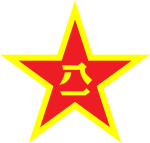Chinese People's Liberation Army Forces Hong Kong Building
Buildings and structures completed in 1979Central, Hong KongEngvarB from July 2014Military of Hong KongSkyscraper office buildings in Hong Kong

The Chinese People's Liberation Army Forces Hong Kong Building is a 113-metre (371 ft) tall, 28-floor building located within the former HMS Tamar naval base on Lung Wui Road, Admiralty, Hong Kong. It serves as the headquarters of the People's Liberation Army Hong Kong Garrison. The building is still popularly known by its old name as the Prince of Wales Building (Chinese: 威爾斯親王大廈) and is located adjacent to Tamar.
Excerpt from the Wikipedia article Chinese People's Liberation Army Forces Hong Kong Building (License: CC BY-SA 3.0, Authors, Images).Chinese People's Liberation Army Forces Hong Kong Building
Tim Wa Avenue, Hong Kong Island Admiralty (Central and Western District)
Geographical coordinates (GPS) Address Nearby Places Show on map
Geographical coordinates (GPS)
| Latitude | Longitude |
|---|---|
| N 22.281666666667 ° | E 114.16416666667 ° |
Address
中環軍營 Central Barracks
Tim Wa Avenue
Hong Kong Island, Admiralty (Central and Western District)
Hong Kong, China
Open on Google Maps









